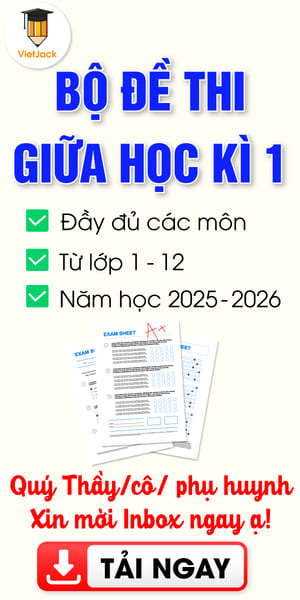Giáo án Tiếng Anh lớp 5 Global Success Unit 4 Lesson 1
Giáo án Tiếng Anh lớp 5 Global Success Unit 4 Lesson 1
Chỉ từ 200k mua trọn bộ Kế hoạch bài dạy (KHBD) hay Giáo án Tiếng Anh lớp 5 Global Success bản word chuẩn kiến thức, trình bày đẹp mắt, dễ dàng chỉnh sửa:
- B1: gửi phí vào tk:
1133836868- CT TNHH DAU TU VA DV GD VIETJACK - Ngân hàng MB (QR) - B2: Nhắn tin tới Zalo VietJack Official - nhấn vào đây để thông báo và nhận giáo án
I. OBJECTIVES
By the end of this lesson, pupils will be able to:
1. Knowledge and skills
- understand and correctly repeat the sentences in two communicative contexts focusing on asking and answering questions about personal information;
- correctly say the words and use What do you like doing in your free time? – I like _____. to ask and answer questions about hobbies;
- enhance the correct use of What do you like doing in your free time? – I like _____ . to ask and answer questions about hobbies in freer contexts;
- use the phrases play the violin, surf the Internet, go for a walk, water the flower in relation to the topic “Hobby”.
2. Competences
- Critical thinking and creativity: learn how to ask and answer questions about hobbies correctly and fluently.
- Communication and collaboration: work in pairs and groups to complete the learning tasks.
- Self-control & independent learning: perform pronunciation and speaking tasks.
3. Attributes
- Explore new interests and develop healthier and balanced lifestyle, then improve general well-being.
II. MATERIALS
- Pupil’s book: Page 28
- Audio tracks 35, 36
- Teacher’s guide: Pages 61, 62, 63, 64
- Website hoclieu.vn
- Flash cards/ pictures and posters (Unit 4)
- Computer, projector, …
III. PROCEDURES
1. WARM-UP (5 minutes)
a. Objectives
- To review and get pupils ready for the new lesson.
b. Content
- Sing a song/ Answer the questions.
c. Expected outcomes
- Pupils can sing the song and answer the questions.
d. Organisation
TEACHER’S ACTIVITIES |
PUPILS’ ACTIVITIES |
CONTENT |
Sing a song | ||
|
- Greet the class. - Then have pupils sing along the song My friends and clap their hands. - Ask pupils the lead-in questions: + Do you go to school in the evenings or at the weekends? + What do you do when you are free? - Write the title Our free-time activities on the board and model it for the class to repeat a few times. |
- Pupils sing the song. - Pupils listen and answer the questions. - Pupils listen and repeat. |
|
e. Assessment
- Performance products: Pupils’ performance and pronunciation
- Assessment tools: Observation
2. ACTIVITY 1: EXPLORATION (5 minutes)
a. Objectives
- To understand and correctly repeat the sentences in two communicative contexts in which characters ask and answer questions about what someone likes doing in their free time.
b. Content
- Activity 1. Look, listen and repeat.
c. Expected outcomes
- Pupils can understand and correctly repeat the sentences in two communicative contexts in which characters ask and answer questions about what someone likes doing in their free time.
d. Organisation
TEACHER’S ACTIVITIES |
PUPILS’ ACTIVITIES |
CONTENT |
Activity 1. Look, listen and repeat. (Track 35) | ||
|
Step 1: Have pupils look at Pictures a and b, identify the characters and their activities. Step 2: Ask pupils to look at the pictures. Play the recording for them to listen. Play the recording again, sentence by sentence, for pupils to listen and repeat. Correct their pronunciation where necessary. Step 3: Play the recording again for pupils to listen and repeat in chorus, sentence by sentence. Step 4: Invite a few pairs to the front of the classroom to listen to and repeat the sentences in the recording. Step 5: Draw their attention to the question What do you like doing in your free time, Mary? and the answer I like playing the violin. Tell pupils that they are the question and the answer about what someone likes doing in their free time. |
- Pupils look at Pictures a and b and identify the characters and their activities in the pictures. - Pupils look at the pictures and listen to the recording. Pupils listen to the recording again, sentence by sentence, and repeat. - Pupils listen to the recording again and repeat in chorus, sentence by sentence. - Pairs of pupils come to the front of the classroom to listen to and repeat the sentences in the recording. - Pupils pay attention to the question and the answer. Pupils listen to the teacher’s explanation. |
– Context a: Mary phoning Nam asking what he’s doing Mary: What are you doing, Nam? Nam: I’m watching a cartoon. I like watching cartoons in my free time. – Context b: Mary answering Nam’s question Nam: What do you like doing in your free time, Mary? Mary: I like playing the violin. |
e. Assessment
- Performance products: Pupils’ answers and pronunciation
- Assessment tools: Observation; Questions & Answers
3. ACTIVITY 2: KNOWLEDGE CONSTRUCTION (10 minutes)
a. Objectives
- To correctly say the words and use What do you like doing in your free time? – I like _____. to ask and answer questions about what someone likes doing in their free time.
b. Content
Activity 2. Listen, point and say.
c. Expected outcomes
- Pupils can correctly say the words and use What do you like doing in your free time?
– I like ________. to ask and answer questions about what someone likes doing in their free time.
d. Organisation
TEACHER’S ACTIVITIES |
PUPILS’ ACTIVITIES |
CONTENT |
Activity 2. Listen, point and say. (Track 36 ) | ||
|
Step 1: Have pupils look at the Pictures a, b, c and d and identify the characters and their activities. Step 2: Have pupils point at Picture a, listen to the recording and repeat the words (playing the violin). Point at the words and Picture a and have pupils listen and repeat after the recording (What do you like doing in your free time? - I like playing the violin). Step 3: Follow the same procedure with the other three pictures. Have the class repeat the questions and answers a few times. Step 4: Have pairs practise asking and answering the question What do you like doing in your free time? - I like _____. Step 5: Invite a few pairs to point at the pictures and say the questions and answers in front of the class. Extension: Have pupils look at the pictures again. One half of the class should ask questions and the other half should answer. Then switch roles. |
- Pupils look at the pictures and identify the characters and their activities. - Pupils point at Picture a, listen to the recording and repeat the word. Pupils follow the teacher’s instructions with the other three pictures. Pupils repeat the words a few times. - Pupils listen and repeat after the recording. Pupils look at Picture a and listen and repeat after the recording. Pupils follow the teacher’s instructions with the other three pictures. - Pupils work in pairs to practise asking and answering the question, using speech bubbles and Pictures a, b, c and d. - Pairs of pupils point at the pictures and say the questions & answers in front of the class. - Pupils look at the pictures again. One half of the class should ask questions and the other half should answer. Then switch roles. |
– Picture and word cues: a. a girl playing the violin and the words play the violin underneath b. a boy surfing the Internet and the words surf the Internet underneath c. a boy going for a walk and the words go for a walk underneath d. a girl watering the flowers and the words water the flowers underneath – Speech bubbles: What do you like doing in your free time? I like ________. Audio script: a. play the violin b. surf the Internet c. go for a walk d. water the flowers a. A: What do you like doing in your free time? B: I like playing the violin. b. A: What do you like doing in your free time? B: I like surfing the Internet. c. A: What do you like doing in your free time? B: I like going for a walk. d. A: What do you like doing in your free time? B: I like watering the flowers. |
e. Assessment
- Performance products: Pupils’ talks and interaction
- Assessment tools: Observation; Questions & Answers
4. ACTIVITY 3: PRACTICE (8 minutes)
a. Objectives
- To correctly use What do you like doing in your free time? - ____. to ask and answer questions about what someone likes doing in their free time in a freer context.
b. Content
- Activity 3. Let’s talk.
c. Expected outcomes
- Pupils can correctly use What do you like doing in your free time? - ____. to ask and answer questions about what someone likes doing in their free time in a freer context.
d. Organisation
TEACHER’S ACTIVITIES |
PUPILS’ ACTIVITIES |
CONTENT |
Activity 3. Let’s talk. | ||
|
Step 1: Draw pupils’ attention to the pictures. Ask questions to help them identify the context (see Input). Step 2: Point at the first character and elicit the question in the first speech bubble (What do you like doing in your free time?). Using the boy who is surfing the Internet as the cue, elicit an answer to complete the second speech bubble (I like surfing the Internet.) as an example. Then write the question and answer on the board. Get pupils to say them. Repeat the same procedure with three other pictures. Step 3: Put pupils into pairs and have them practise asking and answering questions about what someone likes doing in their free time. Go around the classroom to offer support where necessary. Step 4: Invite a few pairs to the front of the class to ask and answer questions about what someone likes doing in their free time, using the picture cues. Praise pupils if they perform well. |
- Pupils look at the pictures and answer the questions. - Pupils look at the bubbles to understand how the sentence pattern is used. Pupils follow the teacher’s instruction. - Pupils role-play to practise asking the questions and giving their answers in pairs, using the picture cue. - Pairs of pupils practise asking and answering questions in front of the class. - Pairs of pupils ask and answer questions about the real activities they like doing in their free time. |
Picture cues: a boy surfing the Internet, a girl watering the flowers, a boy going for a walk, a girl playing the violin – Speech bubbles: What do you like doing in your free time? -______. |
................................
................................
................................
Trên đây là nguồn học liệu Giáo án Tiếng Anh lớp 5 Global Success miễn phí của NXB Giáo dục Việt Nam. Để xem chi tiết, mời bạn tham khảo: Giáo án Tiếng Anh lớp 5 Global Success (NXB Giáo dục)
Để mua Kế hoạch bài dạy (KHBD) hay Giáo án Tiếng Anh lớp 5 năm 2025 mới nhất, mời Thầy/Cô vui lòng xem thử:
Xem thêm các bài soạn Giáo án Tiếng Anh lớp 5 Global Success (bộ sách Kết nối tri thức) chuẩn khác:
Tủ sách VIETJACK shopee lớp 1-5 (2025):
Đã có app VietJack trên điện thoại, giải bài tập SGK, SBT Soạn văn, Văn mẫu, Thi online, Bài giảng....miễn phí. Tải ngay ứng dụng trên Android và iOS.
Theo dõi chúng tôi miễn phí trên mạng xã hội facebook và youtube:Loạt bài Giáo án Tiếng Anh lớp 5 mới nhất của chúng tôi được biên soạn theo mẫu Kế hoạch bài dạy (KHBD) Tiếng Anh lớp 5 của Bộ GD&ĐT.
Nếu thấy hay, hãy động viên và chia sẻ nhé! Các bình luận không phù hợp với nội quy bình luận trang web sẽ bị cấm bình luận vĩnh viễn.
- Giáo án lớp 5 (các môn học)
- Giáo án điện tử lớp 5 (các môn học)
- Giáo án Toán lớp 5
- Giáo án Tiếng Việt lớp 5
- Giáo án Khoa học lớp 5
- Giáo án Đạo đức lớp 5
- Giáo án Lịch Sử và Địa Lí lớp 5
- Giáo án Tin học lớp 5
- Giáo án Công nghệ lớp 5
- Đề thi lớp 5 (các môn học)
- Đề thi Tiếng Việt lớp 5 (có đáp án)
- Bài tập cuối tuần Tiếng Việt lớp 5(có đáp án)
- Đề thi Toán lớp 5 (có đáp án)
- Bài tập cuối tuần Toán lớp 5 (có đáp án)
- Ôn hè Toán lớp 5 lên lớp 6
- Đề thi Tiếng Anh lớp 5 (có đáp án)
- Đề thi Khoa học lớp 5 (có đáp án)
- Đề thi Lịch Sử & Địa Lí lớp 5 (có đáp án)
- Đề thi Đạo Đức lớp 5 (có đáp án)
- Đề thi Tin học lớp 5 (có đáp án)
- Đề thi Công nghệ lớp 5 (có đáp án)




 Giải bài tập SGK & SBT
Giải bài tập SGK & SBT
 Tài liệu giáo viên
Tài liệu giáo viên
 Sách
Sách
 Khóa học
Khóa học
 Thi online
Thi online
 Hỏi đáp
Hỏi đáp

